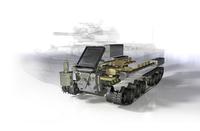-
DOE seizes $21 million from Fisker after company fails to make monthly payment on loan
The administration seized $21 million from auto company Fisker Automotive, less than a month after the automaker laid off three quarters of its employees due to financial and production problems. Fisker, based in Anaheim, California, was awarded a $192 million loan as part of a program started by the Obama administration to boost electric cars and other alternative-fuel vehicles.
-
-
Winner announced in the first DARPA FANG Challenge

The Ground Systems team outpaces more than 200 teams and 1,000 participants, submitting the winning mobility in the Fast Adaptable Next-Generation Ground Vehicle (FANG) Mobility/Drivetrain Challenge, and drivetrain subsystem design and claiming the $1 million prize.
-
-
U.S. science teachers are not fully prepared for new science teaching standards
New voluntary guidelines for science education were unveiled earlier this month by the advocacy group Achieve in collaboration with twenty-six states. The new standards call for more hands-on learning and analysis and cover fewer science topics, but in greater depth.A new report says, however, that America’s K-12 teachers are not fully prepared to meet a new set of science standards.
-
-
New submarine hunting program reaches milestones
DARPA’s Distributed Agile Submarine Hunting (DASH) Program has tested two complementary prototype systems as part of its Phase 2 development effort. The prototypes demonstrated functional sonar, communications, and mobility at deep depths. The successful tests furthered DASH’s goals to apply advances in deep-ocean distributed sonar to help find and track quiet submarines.
-
-
DARPA shows smaller pixels, smaller thermal cameras for soldiers
The U.S. military uses long-wave infrared (LWIR) cameras as thermal imagers to detect humans at night. These cameras are usually mounted on vehicles as they are too large to be carried by a single soldier and are too expensive for individual deployment. DARPA researchers, however, recently demonstrated a new five-micron pixel LWIR camera that could make this class of camera smaller and less expensive.
-
-
Interior Dept. releases progress report on U.S. Water Census
The U.S. Interior Department issued released a report to Congress on the progress of the National Water Census. As competition for water grows — for irrigation of crops, for use by cities and communities, for energy production, and for the environment — the need for the National Water Census and related information and tools to aid water resource managers also grows. The Water Census will assist water and resource managers in understanding and quantifying water supply and demand, and will support more sustainable management of water resources.
-
-
Robot makes inspecting power lines simple, inexpensive

Mechanical engineers invented a robot designed to scoot along utility lines, searching for damage and other problems that require repairs. Made of off-the-shelf electronics and plastic parts printed on an inexpensive 3D printer, the SkySweeper prototype could be scaled up for less than $1,000, making it significantly more economical than the two models of robots currently used to inspect power lines.
-
-
Scientists discover new materials to capture methane
Scientists have discovered new materials to capture methane, the second highest concentration greenhouse gas emitted into the atmosphere. Unlike carbon dioxide, the largest emitted greenhouse gas, which can be captured both physically and chemically in a variety of solvents and porous solids, methane is completely non-polar and interacts very weakly with most materials.
-
-
First U.S. commercial enhanced geothermal system connected to the grid

Enhanced geothermal system (EGS) projects capture power from intensely hot rocks, buried thousands of feet below the surface, which lack the permeability or fluid saturation found in naturally occurring geothermal systems. The Energy Department the other day announced the U.S. first commercial EGS project which supplies electricity to the grid.
-
-
Former NRC chairman: all 104 U.S. nuclear reactors suffer from “irreparable” safety issues
According to former U.S. Nuclear Regulatory Commission (NRC) chairman Gregory Jaczko, all 104 nuclear reactors in the United States currently have irreparable safety issues and should be shut down and replaced. Jaczko was the NRC chairman from 2009 through 2012.
-
-
Critics: Fukushima-influenced U.S. nuclear accident response procedures are flawed
The U.S. government is using the Fukushima nuclear disaster in Japan two years ago as a model for rewriting its plans on how to respond to radiation contamination — emphasizing long-term cleanup and return of residents to affected areas instead of emergency response. Critics say this is a mistake.
-
-
Giant snails invade Florida

South Florida has found itself in battle with a destructive invasive species known as the giant African land snail. The snail can grow as big as a rat and can eat plaster.
-
-
Direct CO2 removal could lower costs of climate mitigation
Two broad strategies are typically offered to protect infrastructure from the consequences of climate change: reducing to emissions of CO2 into the atmosphere by using less fossil fuels, and mitigation (building sea walls, dams, and levees; changing building codes, etc.). Both approaches are costly. Scientists suggest that directly removing CO2 from the air could alter the costs of climate change mitigation. It could allow prolonging greenhouse-gas emissions from sectors like transport which are difficult, and thus expensive, to turn away from using fossil fuels.
-
-
Population growth a challenge to secure supplies of energy, food, water
Mention great challenges in feeding a soaring world population, and thoughts turn to providing a bare subsistence diet for poverty-stricken people in developing countries. An expert says, however, that there is a parallel and often-overlooked challenge: the global population will rise from seven billion today to almost nine billion people by 2040. Providing enough food to prevent starvation and famine certainly will be a daunting problem.
-
-
Footwear safety reflectors help in detecting bioterror threats

Tiny versions of the reflectors on sneakers and bicycle fenders that help ensure the safety of runners and bikers at night are moving toward another role in detecting bioterrorism threats and diagnosing everyday infectious diseases, scientists said the other day.
-
More headlines
The long view
Encryption Breakthrough Lays Groundwork for Privacy-Preserving AI Models
In an era where data privacy concerns loom large, a new approach in artificial intelligence (AI) could reshape how sensitive information is processed. New AI framework enables secure neural network computation without sacrificing accuracy.
AI-Controlled Fighter Jets May Be Closer Than We Think — and Would Change the Face of Warfare
Could we be on the verge of an era where fighter jets take flight without pilots – and are controlled by artificial intelligence (AI)? US R Adm Michael Donnelly recently said that an upcoming combat jet could be the navy’s last one with a pilot in the cockpit.
The Potential Impact of Seabed Mining on Critical Mineral Supply Chains and Global Geopolitics
The potential emergence of a seabed mining industry has important ramifications for the diversification of critical mineral supply chains, revenues for developing nations with substantial terrestrial mining sectors, and global geopolitics.
AI and the Future of the U.S. Electric Grid
Despite its age, the U.S. electric grid remains one of the great workhorses of modern life. Whether it can maintain that performance over the next few years may determine how well the U.S. competes in an AI-driven world.
Using Liquid Air for Grid-Scale Energy Storage
New research finds liquid air energy storage could be the lowest-cost option for ensuring a continuous power supply on a future grid dominated by carbon-free but intermittent sources of electricity.
Enhanced Geothermal Systems: A Promising Source of Round-the-Clock Energy
With its capacity to provide 24/7 power, many are warming up to the prospect of geothermal energy. Scientists are currently working to advance human-made reservoirs in Earth’s deep subsurface to stimulate the activity that exists within natural geothermal systems.
